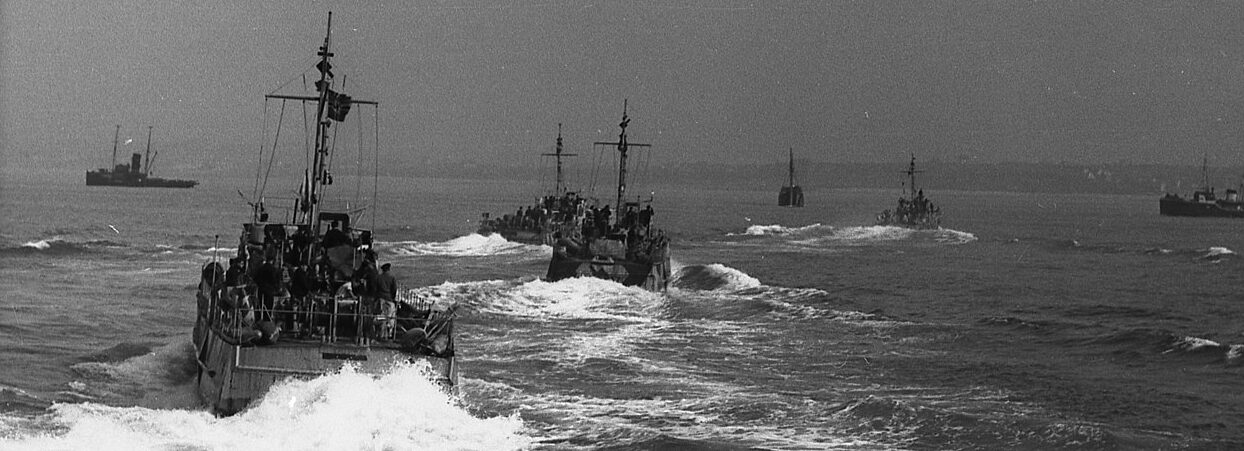
Introduction:
The Räumboote, or “R-Boote” were the mass-produced wooden-built German coastal minesweepers. In time, they also performed other missions, notably escort, ASW patrol and rescue. They were built from 1929 with the following R1, R17, R25, R41, R130, R151, R218, R301 and R401 classes, the latter mostly not completed at end of the war. In total, the Kriegsmarine operated 424 R-Boote from Lürssen, Bremen-Vegesack, Abeking & Rasmussen, Lemwerder at Schlichting. They soldiered in the Baltic, Norway, Channel and German bight, Mediterranean and Black sea, distributed among 19 flotillas. 140 surviving boats of the Räumboots-Flottille were used postwar by the Mine Sweeping Administration (GMSA) predecessor to the Bundesmarine. #ww2 #kriesgmarine #rboote #raumboote https://bit.ly/3AbPFbV
The German light minesweepers of WW2
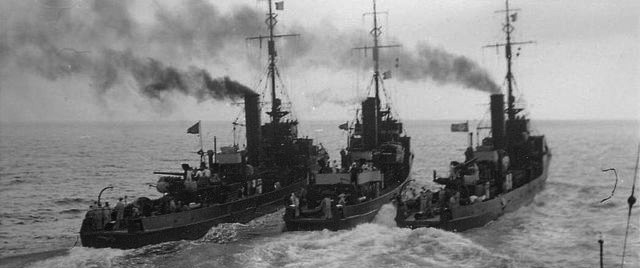
“M-Boote”: The large fleets of WWI minesweepers were stil active in WW2. here, three M-Boote in 1938.
Germany was serious about mine warfare in WW1, but commenced late. The first dedicated minesweeper only appeared in 1915: It was the M1 class, of which 26 were built, followed by the 30 of the M27 and 30 of the M57 classes, judged os such quality they were almost all still in service in WW2, but also was interested in built cheaper, mass-produced motor minesweepers (MMS) for coastal operations. The FM type (66 boats in 1918-19) and F Type (1915-18, 75 boats) were seconded by the experimental LM boats (1917-18) which are the true ancestors of WW2 R-Bootes.
The Reischmarine’s Räumboote concept
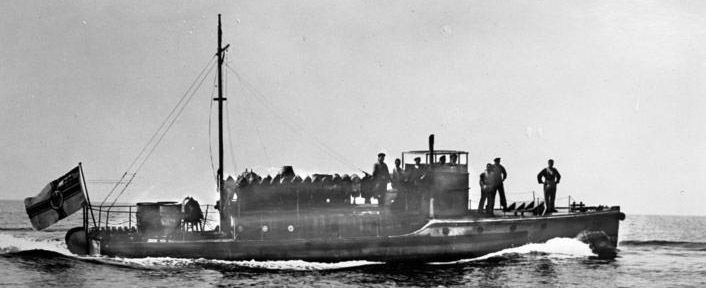
The idea of building R-Bootes, or Räumboote (minesweepers), designed as moderately light boat for coastal operation was an idea driven by WWI experience, showing the intensive use of sea mines revealing the need for specialized boats alongside the larger and coastlier M-Boote built en masse. To deal with many minefield laid in coastal waters and aroud inlets notably in the gulf of Finland, other, light shallow-draught boats were needed, more suitable than M-Boote, tailored the high seas.
At first, converted boats such as tugboats and fishing vessels were primarily used to clear mines in the foreshore. From 1915, the Imperial Navy developed the motor “F-boats” (shallow mine clearance boats) for shallow mines as indicated, something that was sorely lacking. These were the real forerunners of the R-Bootes.
True ancestors: The “F-Boats”
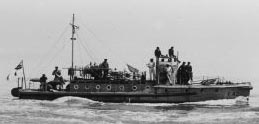 The F-Boats were built from 1915 and until 1918, to an extent of 75 boats. They were alight wooden-hulled designisable for harbour duties and deployed from specially modified depot ships, the converted ex-pre-dreadnoughts SMS Wittelsbach, Schwaben, Preussen, and Lothringen. When deployed they acted as advanced bases and main defensive platforms as well. Of these 75 boats completed, only one was lost by a mine explosion. After the war they served for harbour and riverine duties under the Reichsmarine, Police and Riverine patrol. 12 were also sold to Belgium, still around in 1940.
The F-Boats were built from 1915 and until 1918, to an extent of 75 boats. They were alight wooden-hulled designisable for harbour duties and deployed from specially modified depot ships, the converted ex-pre-dreadnoughts SMS Wittelsbach, Schwaben, Preussen, and Lothringen. When deployed they acted as advanced bases and main defensive platforms as well. Of these 75 boats completed, only one was lost by a mine explosion. After the war they served for harbour and riverine duties under the Reichsmarine, Police and Riverine patrol. 12 were also sold to Belgium, still around in 1940.
The interwar birth of Mine Hunters
After the First World War, the Reichsmarine had to clear sea routes in the German area of responsibility for mines. In the winter of 1919/20 alone, over 100,000 mines were cleared. They were mostly anchored mines, but in view of newly developed or under development mine types, such as ground mines, magnetic field mines, electromagnetic mines, acoustic mines, etc., special boats were required. They were restrospectively the first “mine hunters”, built as non-magnetic as possible, manoeuvrable and not too large for use in coastal waters.
The Räumboot type was born, the initial design task was given to Abeking & Rasmussen (A&R) shipyard in Lemwerder, Netherlands, in the 1920s, to conceal the activity from the Versailles treaty commission. The first boats were built in 1929-1934 (R 1-8) by Lürssen and A&R (R9-16). They were unarmed at the time and could be “sold” to inspectors as harbour duty ships, or just for their intended purposes and contribute to the clearing of sea mines.
An Innovative Type, a-magnetic and with VS drive
The type supplied by the two shipyards largely corresponded to the requirements of the Reichsmarine and they were mostly built of wood, some like R 8, and R 17-24 provided with the new Voith-Schneider drive (VS): The latter’s principle was strikingly simple: The magnitude and direction of thrust can be set steplessly, using circular disk with movable and controllable blades installed at a 90 degree angle for the disk to rotates at the vessel bottom. The magnitude of thrust is determined by the rotational speed of the disk and blade angle determines the direction of thrust. For these R-Boote, they were horizontally mounted propellers, perfect for precise maneuvering even under adverse conditions. But these were complex systems which were in short supply.

Voith-Schneider System
As the result, these interwar R-Boote were very manoeuvrable and powerful in order to give the clearing gear the required pulling power. The demand for non-magnetic materials for the engines however could only be realized after the Second World War. The Bundesmarine Schütze-class fast minesweepers were the first totally a-magnetic minehunters built in the world. However, the the WW2 boats were equipped MES system (a kind of degaussing system), greatly reducing the magnetic field.
Gradual Improvement
The first boats displaced 60 t and were made of composite construction (steel frames with wood planking) with MWM diesel engines developing 714 hp acting on two propeller screws, or Voith-Schneider propellers.
Next came the R 17-24 (all by A&R) with 115 t displacement and 1836 hp in the years 1934 to 1938, so assigned to the Kriegsmarine, which naval staff did not developed a strong interest for these, but rather preferred to concentrate on the S-Boote.
R 25-R 40 were boats of 110 t displacement, with class screw propeller drive built in 1938/1939. They were all provided with an air-cooled Deutz diesel generator providing electricity for clearing magnetic mines, installed in a housing on the upper deck. These were the first “magneic mine specialists”. For this serie, it was looked at using them in a more offensive way, notably fitting them with mines, inclusing magnetic ones, since they were the right kind of boat to lay them with safety.
As the Second World War grew near, the construction program was greatly expanded. A grand total of 424 Räumboote were built based on the same predecessor type. The majority had conventional propellers due to production bottlenecks notably for the VS system, and due to a lack of armament-related. R 41-150 received VS propellers anyway. Shipyards responsible for this wartime production were A&R Lemwerder, Burmester shipyards (Bremen) and Swinemünde as well as Schlichting shipyard (Travemünde).
R-Boote Tactics
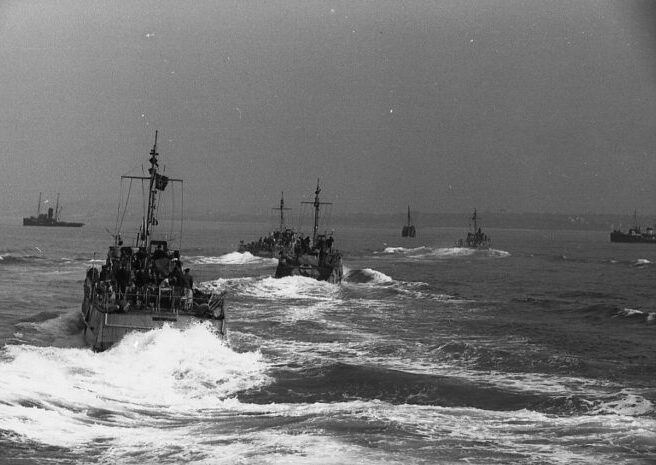
Organization
The R-boats proved to be extremely robust and versatile. Apart S-Boote, already well budy with the Torpedo tasks, the lack of fast, large motor boats soon had the Räumboote providing tasks during the war for which they were never intended: They were used to secure convoys, minelaying, ASW patrols, escorting U-boats in and out of their bases and sea rescue, both for the Kriegsmarine and Luftwaffe.
The tactics were simple, originally they were intended to serve in small squadrons of six boats, but were to be assisted by an armed depot ship/tender. Ideally specialized, a bit like the pre-dreadnought depot ship concept of 1918.
However these specialized R-Boote depot ships fell short due to arbitrations in the Kriegsmarine. Large, well armed and modern dedicated depot ships were assigned primarily to U-Boats (Saar, W. Baer class and converted merchant ships) and others to the S-Bootes (Tsingtau, Tanga, Lüderitz, Nachtigal classes).
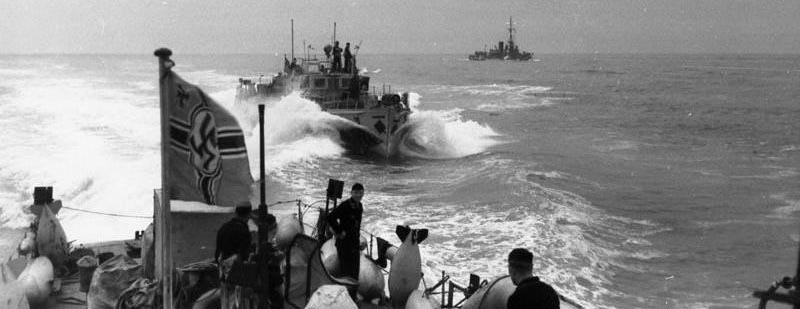
In the end, since they were coastal boats, they were assigned larger minsweepers: Von der Groeben, Alders, Raule, Juningen, Nettelbeck, Von der Lippe, Brommy, Hille were all ex-minesweepers of the WWI series. Nordpol, Nordsee, Gazelle, Nadir, Schwertfisch, Weser, Barbara, Rigel, were very diverse ships which were essentially “what was available”, and with time in 1943-44, some unit operated without a tender/escort at all.
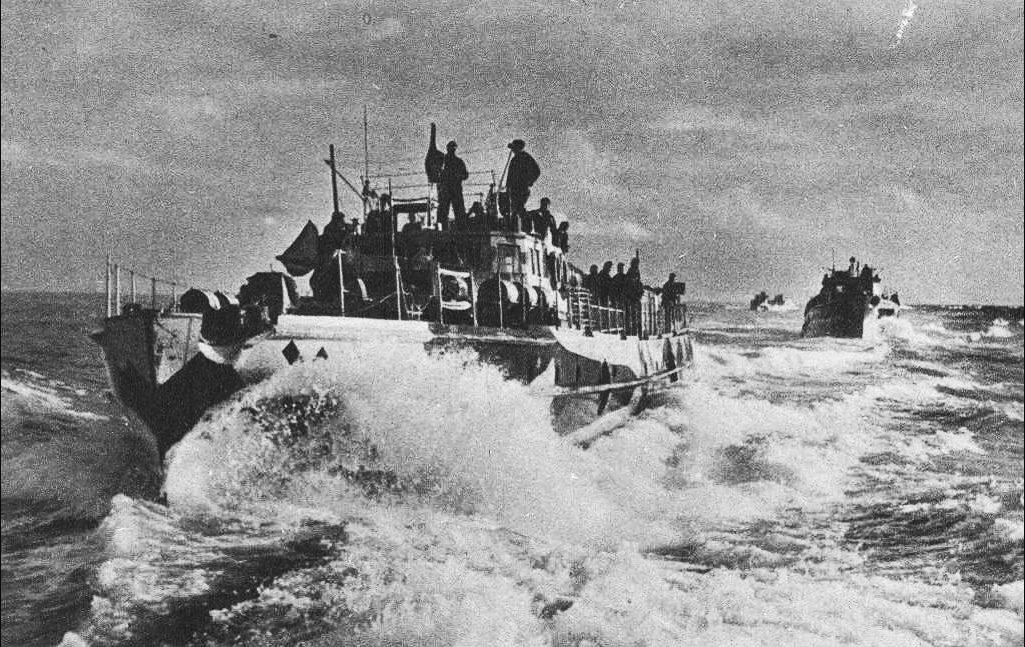
A flotilla of R-41 class boats advancing at high speed, apparently for submarine hunting, as the boat in the foreground has an additional pattern of depth charges on its foreship (shipsnostalgia).
Gazelle was the last former WWI cruiser, Barbara was a Flakschiff (Former Belgian Zinnia), Nordsee/Nordpol were 1914 tenders…
When deployed at sea, the depot ship stayed behind, operating long range-communication with the HQ and defense based on its better armament, but also providing spares and supplies for the R-Boote. A minesweeping operation was in general a 24-hours affair at the most depending of the technicity of the mines and size of the minefield.
Operations
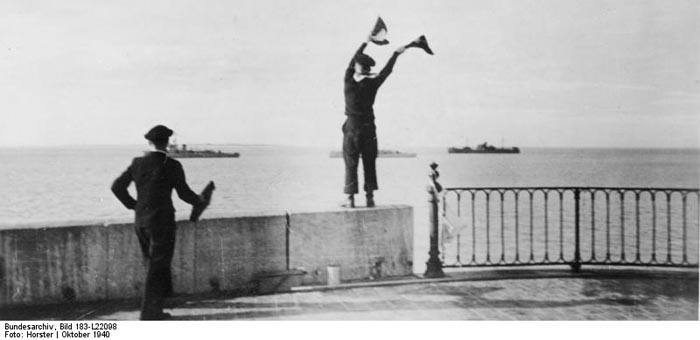
PK-Horster-Scherl picture service
The first 16 small pre-war boats built were transferred to the Mediterranean (RF 12) by inland waterways and overland, but none survived the war. Some by the same paths found their way into the black sea fleet (RF 30), and operated alongside the Romanian Navy until the Soviet counter-offensive drove them out. Some units served in the Baltic, close to still Soviet-held ports and made riverine operations when possible. Others operated in the German bight, the channel, and around north sea sandbanks, as well as around Heligoland and from Norway. There was also unit dedicated to training (RF 17), with more than 400 R-Boote in service, this was quite necessary. Because of their light armament, many were destroyed or damaged during wartime.
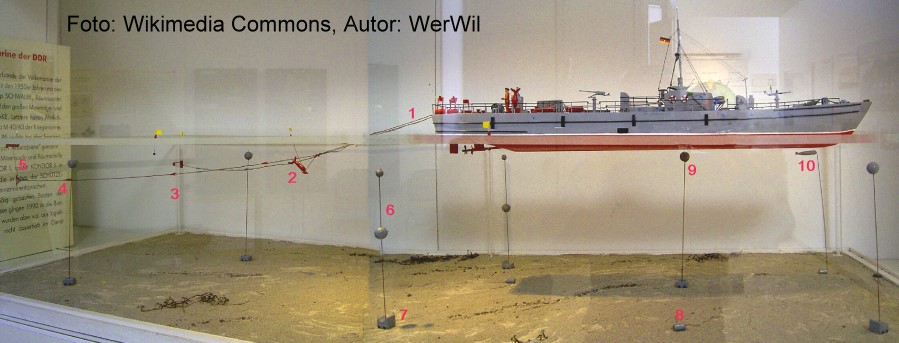
Wikimedia commons photo showing the deployment of a R-Boote in shallow waters.
One interesting use was from the narrow fjords of occupied Norway. In October 1940 the unit commanding officer, Kapitanleutnant Hans Bartels, commissioned the construction of his twelve own highly successful small vessels based on Norwegian fishing boat designs, called Zwerge (‘dwarves’). The unit was later called ‘Tigerverband’ based on their pennant bearing a snarling tiger’s head over crossed swords. Later sporting small commemorative pins awarded with a special certificate. High command eventually condemned the initiative and Bartels was relocated on the destroyer Z34.
The Vorpostenboote (‘outpost boats’) recouped many of these units tasked of patrol work, creating outer protective screens for convoys and port guards. At first former whaler, trawlers, captured boats, they were spread into 33 Vorpostenbootflottillen, operating in the Baltic, Denmark, North Sea, France, Holland. They were considerably reinforced during the war as Civilian yards were requitioned and put under the authority of the Kriegsmarine to resume production. The new civilian fishing boat designs were sometimes heavily armed and redesignated as “Kriegsfischcutter” and could also be outfitted for minesweeping and ASW duties. They served alongside, and completed the numerous R-Boote.
As for ASW duties, if very few of the dedicated U-Jagd Boote were specialized vessels in U-Bootsjagd Flottillen, the bulk of operations were made by mixes of R-Boote type minesweepers and the VP-boats see above. The Kriegsmarine still drafted its own specifications for further dedicated sub-hunter, but shipyard priorities decided otherwise. In the end, only the M35 minesweepers were the closest to this type ever. However in this role, the R-Bootes lacked proper sonar and depht charge reserves for effectively chasing submarines.
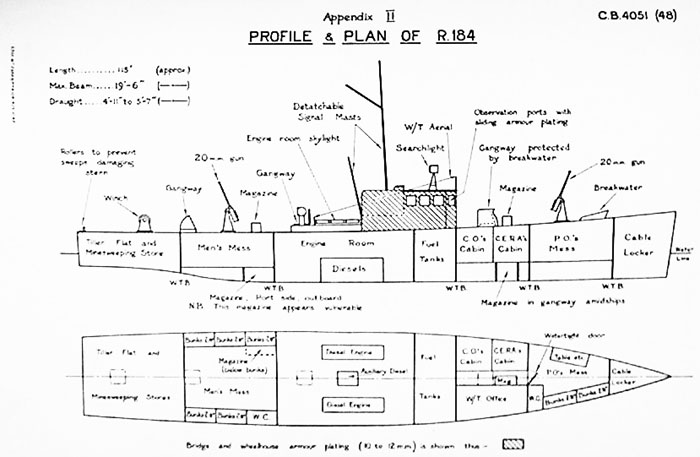
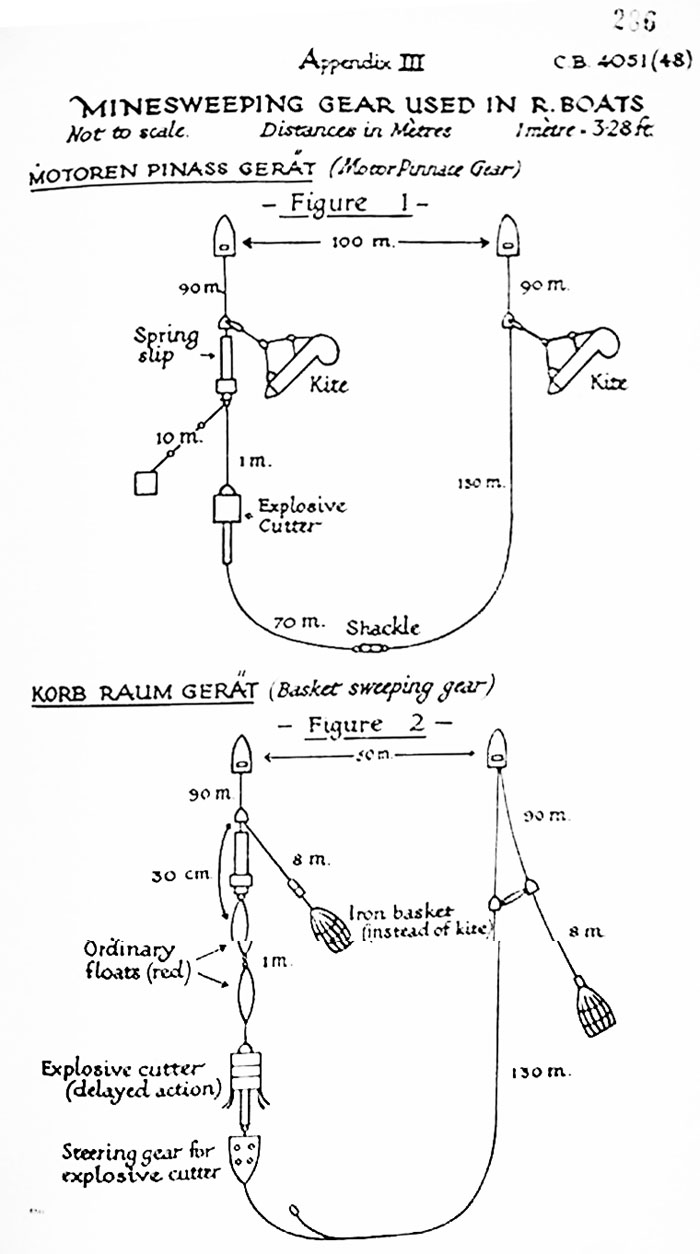
Note that R-184 was captured by the RN and duly examined, leaving a report in 1942 (see later pdf in the sources). Here are two plans, showing the boat plan by British intel, and a scheme of minesweeping operations as reconstructed after interrogating the crew and examining the gear.
Succession: MV-Boote
Probably the most interesting development of the R-Boote type was the Mehrzweckboote or “general purpose boat”, by order of March 1943. It was a powerful, but slow boat with heavier armament. It was intended to replace the R-boats and VP-boats, weighted 290-ton for a 52m x 7.2m hull, single 6-cylinder diesel engine for 14 knots. Two torpedo tubes were fitted near the bow a bit like for S-boats, completed by two 8.8cm, a single 3.7cm two quad “Flakvierling” 2cm flak gun mounts. But of the 12 boats ordered at the Stiilcken yard in Hamburg, only MZ1 was completed before the end of the war. Construction in pre-fabricated sections was envisioned. If MZ1 was launched on 16 April 1944 and tested later that year, the industrial situation Germany was in by that time precluded any progresses. Apart MZ1, only three keels perhaps has been laid down and little work done, with foggy records to say the least, no photos or plans left.
Postwar Fate: GMSA
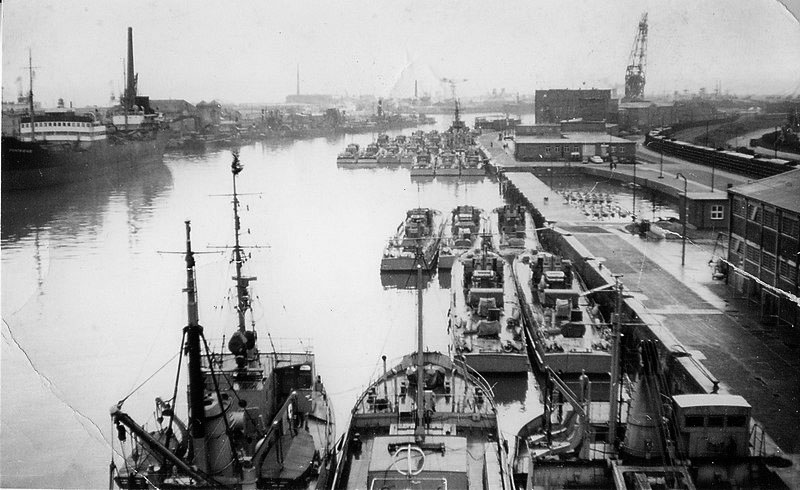
R Boote of the GMSA in 1952
140 survived the war, taken over by the allies. The USA received 48, the USSR 45, Denmark 24, Great Britain 11, the Netherlands 8 and Norway 4.
However they were used to form the “German Minesweeping Service” or “Deutscher Mienenräumdienst” after the war. 24 more were also returned to Germany to form Bundesmarine’s early minesweeper squadrons in 1956, used until the late 1960s. Others were passed on to other allies. Italy and Yugoslavia received some for example.
The German mine clearance Administration, replacing the Kriegsmarine, used these boats to clear the Baltic Sea, German Bight and Norwegian waters, Germany’s area of reponsibility to ensure trade safety. Some were handed over to the water police of Western federal states while R 406 was converted in 1948 as the passenger ship Arngast for island service in the Jade Bay and to Heligoland, became in 1951 the LSU (R 154) and Bundesmarine’s Naval Locating School OT 2, still active in the 1980s.


Indonesian Pulau-Rau class minesweepers in the 1960s
R-Boote Units
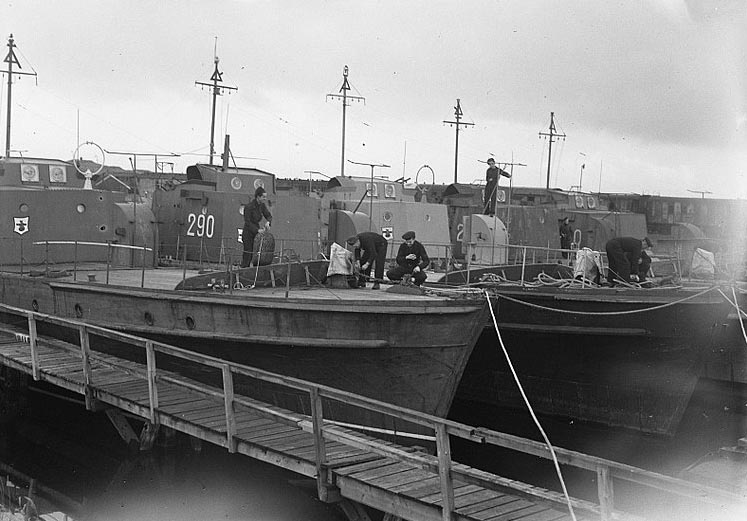
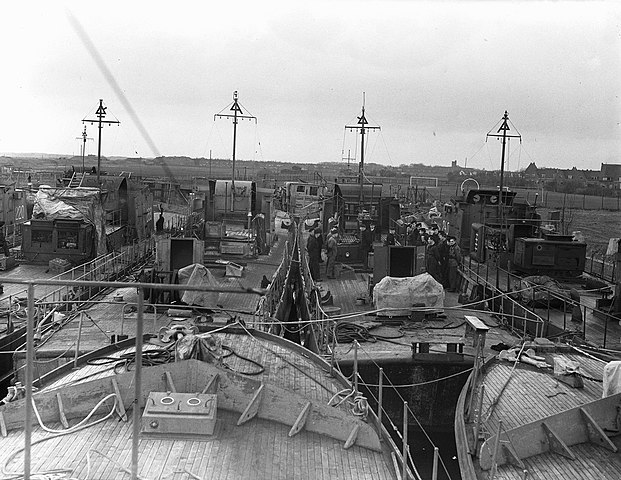
R-Boote based in the Netherlands, the 9. Räumboots-Flottille (rotterdam).
Between the wars and during World War II, a total of 19 Räumboots-Flottille (German for Minesweeper Flottiles) were created (plus one postwar). While most were disbanded at the end of the war or after the German surrender, a few were retained for use by the German Mine Sweeping Administration (German: Deutscher Minenräumdienst or “German Mine Sweeping Administration” or GMSA) and dissolved after the war. An additional flotilla was created in the immediate post-war period, also for use by GMSA1.
1. Räumboots-Flottille:
Established in octobre 1937: R 17, R 18, R 19, R 20, R 21, R 22, R 23, R 24. Other assigned boats: R 43, R 52, R 65, R 66, R 67, R 68, R 69, R 70, R 71, R 72, R 73, R 74, R 75, R 76, R 106, R 119, R 120, R 127, R 128, R 145, R 150, R 249, R 259, R 260, R 268. Escorts assgned: KMS Nettelbeck, Nordpol.
2. Räumboots-Flottille:
Established in november 1938, with the following boats: R 25, R 26, R 27, R 28, R 29, R 29, R 30, R 31, R 32. Other assigned later: R 74, R 77, R 84, R 86, R 113, R 114, R 116, R 125, R 129, R 169. In 1945, the unit was down to a single squadron: R 412, R 413, R 414, R 415, R 416, R 417. KMS Brommy (ex-M50/550) was their tender.
3. Räumboots-Flottille:
Established in 1939 at Pillau, with ship: R 33, R 34, R 35, R 36, R 37, R 38, R 39, R 40. Other later asssigned: R 163, R 164, R 165, R 166 R 196, R 197, R 203, R 204, R 205, R 206, R 207, R 208, R 209, R 216, R 248. Escort and supply ships, KMS Von der Groeben, R-Boat tender. En 1945, the unit had the following: R 270, R 288, R 289, R 418, R 420, R 421, R 422 R 423 with KMS Gazelle as escort.
4. Räumboots-Flottille:
Created by april 1940, with the boats: R 41, R 42, R 43, R 44, R 45, R 46, R 47, R 48, R 49, R 50, R 51, R 52. Other assigned: R 80, R 83, R 115, R 120, R 126, R 128, R 138, R 143, R 150, R 218, R 240, R 243, R 244, R 245, R 246, R 255, R 262, R 274, R 275, R 290, R 291.
5. Räumboots-Flottille:
Created in August 1939 with the boats: R 1, R 3, R 4, R 5, R 6, R 7, R 8, R 9, R 10, R 11, R 12, R 13. In 1941, she was composed of the following: R 53, R 54, R 55, R 56, R 57, R 58, R 59, R 60, R 61, R 62, R 63, R 64. Other assigned: R 89, R 90, R 113, R 121, R 122, R 124, R 238, R 250, R 269, R 273. Escort ship: KMS Elbe.
6. Räumboots-Flottille:
Created in July 1941 at Cuxhaven, with the boats: R 9, R 10, R 11, R 12, R 13, R 14, R 15, R 16. Other assigned: R 1, R 3, R 4, R 6, R 7, R 8, R 115, R 187, RA 10 (former British MTB), and RD-boats: RD 116, RD 117, RD 118, RD 119, RD 120, RD 121, RD 122, RD 127, RD 128, RD 129, RD 130, RD 131.
7. Räumboots-Flottille:
Created in octobre 1940, with the following boats: R 151, R 152, R 153, R 154, R 155, R 156, R 157, R 158, R 159, R 160, R 161, R 162. Other later assigned: R 173, R 202, R 223, R 262, R 277. Eescort and tender ships KMS Weser.
8. Räumboots-Flottille:
Created in january 1942 with the following boats: R 92, R 93, R 94, R 95, R 96, R 97, R 98, R 99, R 100, R 101. Others later assigned: R 113, R 117, R 118, R 130, R 146, R 147, R 257, R 258, R 409. Assigned escort and supply ships: KMS Nadir, Schwertfisch.
9. Räumboots-Flottille:
Created in may–june 1942 in Rotterdam: R 85, R 87, R 88, R 103, R 104, R 105, R 107, R 108, R 109, R 110, R 111, R 112, R 131, R 148, R 149, R 247, R 251, R 412, R 413, R 414, R 415, R 416, R 417 Assigned escort/tender: KMS Alders.
10. Räumboots-Flottille:
Created in february-march 1942 in Cuxhaven. Assigned Boats: R 175, R 176, R 177, R 179, R 180, R 181, R 182, R 183, R 184, R 190, R 213, R 217, R 218, R 219, R 221, R 222, R 224, R 234. Assigned escort/tender: KMS von der Lippe.
11. Räumboots-Flottille:
Created by September 1939, with 8 armed trawlers and an escort. By October 1940 renamed 7. Räumboots-Flottille assigned to battered R-Boote which needs refit for service. From 1942 she is assigned the R 39, R 161, R 162, R 189, R 192, R 198, R 199, R 200, R 201, R 212, R 215, RD 102, RD 103, RD 104, RD 105, RD 109, RD 111, RD 112, RD 113, RD 114, RD 148, RD 149, RA 252, RA 253, RA 254, RA 258, RA 260, RA 261, RA 262, RA 263, RA 264, RA 267, RA 268. No escort ship.
12. Räumboots-Flottille:
Created in may 1942 at Bruges, Belgium, then reassigned to the Mediterrananean, dissolved in february 1945. Assigned boats: R 34, R 38, R 40, R 178, R 185, R 186, R 188, R 190, R 191, R 194, R 195, R 210, R 211. Escort/tender KMS von der Groeben.
13. Räumboots-Flottille:
Created on 15 november 1943 in the Heligoland Bight. In 1957, it was trasferred to the Bundesmarine, via the minesweeping administration. This unit operated the R 132, R 133, R 134, R 135, R 136, R 137, R 138, R 139, R 140, R 141, R 142, R 144, R 177, R 252. They were supplied and escorted by the KMS Nordsee.
14. Räumboots-Flottille:
Created in december 1943, operating in the Channel. After the French invasion in juin 1944 it was rassigned to the Jade and Heligoland bight, and Baltic sea. Assigned boats: R 18, R 214, R 219, R 225, R 226, R 227, R 227, R 228, R 229, R 230, R 231, R 232, R 233, R 235, R 236, R 237, R 242, R 259, R 263. Escort: KMS Barbara.
15. Räumboots-Flottille:
Created 1st July 1944 in the Baltic. These boats were also deployed in Finnish waters. Assigned boats: R 239, R 240, R 241, R 243, R 244, R 245, R 254, R 255, R 256, R 409, R 410, R 411.
16. Räumboots-Flottille:
Created in october 1944 at Haugesund, Norway, dissolvd 25 november 1947. Assigned boats: R 264, R 266, R 267, R 401, R 402, R 403, R 404, R 405, R 406, R 407, R 408, R 424.
17. Räumboots-Flottille:
Created in July 1944 for training R-Boote crews, as Räumbootsflottille zbV, based in the Baltic. Dissolved by late 1947. Assigned boats: R 55, R 71, R 102, R 167, R 170, R 174, R 175, R 176, R 181, R 220, R 241, R 246, R 249, R 290.
21. Räumboots-Flottille:
Created by july 1943, composed of 12 large escort minesweepers (Geleit-Räumbooten) based in Bergen, Norway. Dissolved early 1946. Assigned boats: R 301, R 302, R 303, R 304, R 305, R 306, R 307, R 308, R 309, R 310, R 311, R 312
25. Räumboots-Flottille:
Created in the summer of 1945 in Denmark she ships of various flottillas, by the German Minesweeping Administration, until early 1946. Assigned boats: R 18, R 23, R 65, R 234, R 254, R 257, R 258, R 409, R 410, R 411 with Riegel as escort/tender.
30. Räumboots-Flottille:
Created in june 1943 with Dutch captured minesweepers, reassigned to the black sea. Deactivated by August 1944: R 30, RA 51, RA 52, RA 54, RA 56.
Appareance


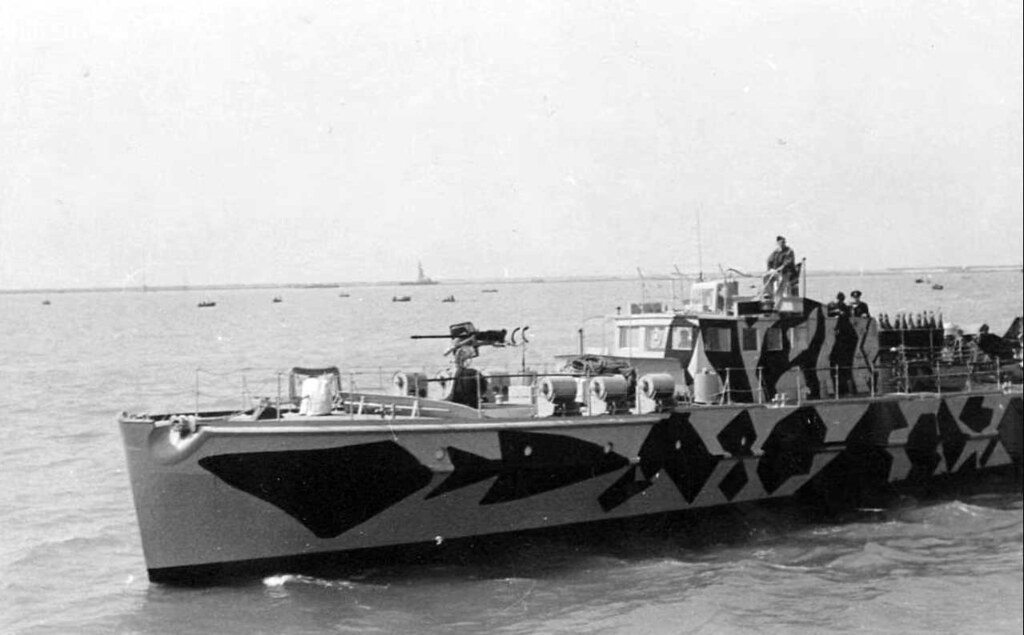

The R-Boats, like the S-Bootes, and even perhaps more often, were camouflaged. Patterns were unregulated, left to the choice of Flotilla Commanders, although they had to apply at least a base pattern which was adapted to the theater of operation on coastal areas. It was the “broken line” pattern with black motives on a dull grey base. Some of the designs were relatively simple, “zebra like” and others were particularly complex, such as this one below.
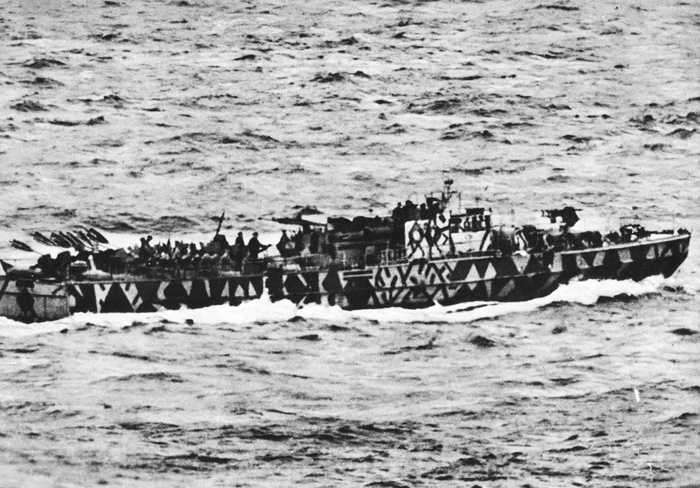
To come in the future: Renditions of various classes and camouflage pattern designs.
Design
As defined by the Reischmarine and confirmed later by the Kriegsmarine, light minesweepers were vital in the event of a naval blockade by the Allies. They were design to lead the way, and also for possible quick sweeps and or even stealthy minelaying. They were larger and much slower than the S-Boote and were considerably reinforced with AA guns.
They were sleek, low profiles, lightly-built, with shallow draughts for coastline use. Their metal understructure was completed by wood framing and they had rounded bilges built-in.
The typical powerplant was fixed around two flexible MAN marine diesels for an output of 1,836 horsepower each on under stern shafts and the VS (Voith-Schneider) system in some cases, a real advantage to manoeuver in minefields. Top speed was not stellar as they managed 17 kts in the best conditions, although the R301-R312 group was modified with a triple-shaft arrangement, enabling a 24 knots speeds. Still not S-Type level, but good enough for hard engagements.
They were also lightly-armed. The typical outfit in 1939 was a single turreted 37mm C/30 aft and two Rheinmetall FLAK c/38 20 mm cannons, up to six in wartime, plus several 7.92mm MG.34 light machine guns for close defense. Minesweeping apparatus was “classic” and derived from the WWI M-class, with however measured taken for improving their ability to defuse magnetic and modern mines of all types. They were also outfitted for minelaying, photos showing them carrying up to six on individual cradles aft, alternative to depth charge racks for ASW escort work. The R301-R312 boats even were fitted with two fixed broadside torpedo launchers (pointing forward), they were pressed especially in the Channel fleet were close encounters were frequent. The crew went up with time, as they received more armament, up to 38 in all.
R-Boote nomenclature
 R 1 class (1929)
R 1 class (1929)

R8 at sea, interwar
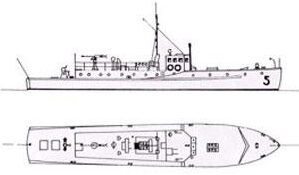 The first group R1 to R16 dated back from 1929. These were small vessels of 26 meters, 60 tonnes with a composite hull, capable of 17 knots. They were still partly inspired by the WWI “F-Boote”. The hull was stepped, with an embeddeded main deck, more typical of service boats than classic warships. The superstructure however was fully enclosed. Armament was reinforced during the war, as by 1943 R1 had four 4 single additional 20mm/65 C/38, and a DCR (Depth Charge Rack) plus ten mines, as the folling boats of the R2 serie, including R8.
The first group R1 to R16 dated back from 1929. These were small vessels of 26 meters, 60 tonnes with a composite hull, capable of 17 knots. They were still partly inspired by the WWI “F-Boote”. The hull was stepped, with an embeddeded main deck, more typical of service boats than classic warships. The superstructure however was fully enclosed. Armament was reinforced during the war, as by 1943 R1 had four 4 single additional 20mm/65 C/38, and a DCR (Depth Charge Rack) plus ten mines, as the folling boats of the R2 serie, including R8.
They were used as patrol, ASW and then rescue ships as the war progressd and new ships were made available. The prototype was created by F.Lürssen, still much inspired by the F type minesweeping boat of WWI.
Fate:
R1 was badly damaged and a total constructive loss (CTL) on 24.11.1943. R2 was discarded in 1942, all the rest were lost in action or scuttled: R3 on 24.11.1943, R4 on 22.2.1945, R5 on 3.1.1940, R6 on 13.8.1943, R7 on 9.9.1943, R9 on 2.8.1942, R10 on 2.5.1945, R11 on 2.8.1942, R12 on 5.9.1944, R13 on 9.9.1943, R14 on 16.3.1945, R15 on 16.4.1945 and R16 2.5.1945.
⚙ R1 specifications |
|
| Displacement | 60 tonnes (R8 63t) |
| Dimensions | 26 x 4.41 x 1.21 m (85ft 3in x 14ft 6in x 4ft) |
| Propulsion | 2 shafts MWM diesels, 700 bhp |
| Speed/Range | 17 kts, 4tons oil, circa 800 nm/13 kts |
| Armament | 1x 20mm/65 C30 FLAK, Minesweeping gear |
| Crew | 19 |
 R 17 class (1934)
R 17 class (1934)
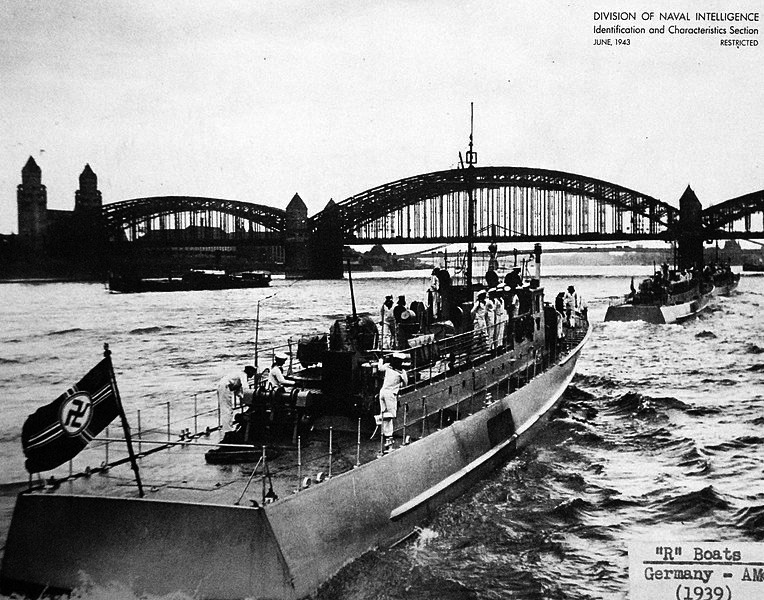
R-Bootes in 1939, ONI photo
From 1934, the R17 group comprised 8 units, which displacement increased to 115 tonnes, for 37 meters in lenght and 21 knots in speed. They came from by Abeking & Rasmussen, and Schlichting yards, with a simplified “flush deck” hull and minimal superstructures. Their minesweeping gear could operate up to a force sea 6 on the Beaufort scale. During the war, in 1943 they rweceived two twin extra 20mm/65 C/38 AA guns and two single ones, plus a DCR. By 1944 the remainder earned a single 86 R Ag M42/43 AA Rocket Launcher. Most were built with the Voith-Schneider propulsion system also.
FATE:
R17 was sunk by the Norwegian minelayer Olav Tryggvason, R19 by Allied aircraft, R20 by a German mine.
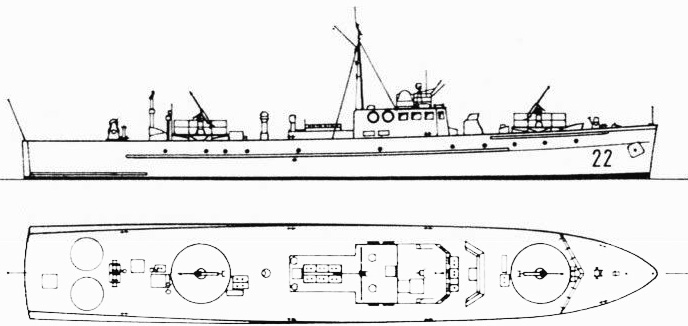
Profile and elevation of the R21
⚙ R17 specifications |
|
| Displacement | 115 tonnes () |
| Dimensions | 27 x 5.50 x 1.30 m () |
| Propulsion | 2 shafts MAN diesels, 1,800 bhp |
| Speed/Range | 21 kts, diesel oil 10.8 tons, 900nm/15 kts |
| Armament | 2x 20mm/65 C30 FLAK, 12 mines, Minesweeping gear, see notes |
| Crew | 17-27 |
 R 25 series (1938)
R 25 series (1938)
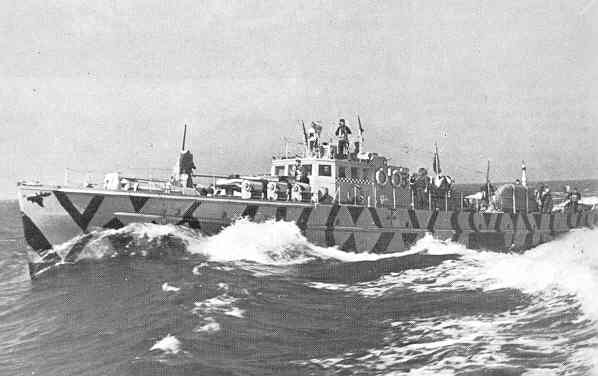
R38, camouflaged, underway Src: http://www.lexikon-der-wehrmacht.de/Gliederungen/Sicherungsflott/R38-1.jpg
Nothing much to say, they were a repeat of the previous design, a bit larger and faster. R25 to 34 had a 1.40 normal draught, 1.42 deep load while R35-40 had a 1.51 deep load draft.
By 1943-1944 survivors were rearmed with a single aft 37mm/80 SK C/30 or or a 37/69 FlaK M/42 and two twin 20mm/65 C/38 AA guns plus one DCR.
Fate: R25 was surrendered in 1945 and transferred to Soviet Union 6.1946. R26, R28, 32 to Denmark 12.1945, R31 to UK. R27 was sunk 11.4.1944, R29 on 23.9.1943, R33 on 19.7.1943, R34 on 10.8.1944, R36 on 29.4.1943, R38 on 27.8.1944, R39 on 17.2.1944 and R40 on 7.3.1943. R35, 37 were scuttled on 30.8.19447.
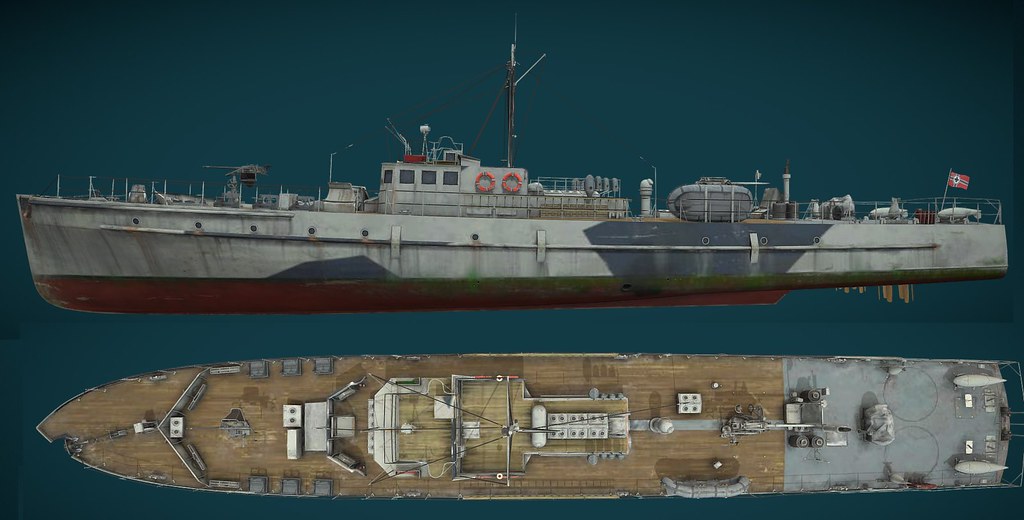
FLICKR, 3D rendition (Gaijin Ent.) of the R25.

R29 plan drawing (FLICKR)
⚙ R25 specifications |
|
| Displacement | 110/126 tonnes (FL) |
| Dimensions | 35.4 x 5.55 x 1.40 m () |
| Propulsion | 2 shafts MAN diesels, 1,800 bhp |
| Speed/Range | 23.5 kts, diesel oil 10 tons, 1100nm/15 kts |
| Armament | 2x 20mm/65 C30 FLAK, 10 mines, Minesweeping gear, see notes |
| Crew | 20 |
 R 41 (mob) series (1943)
R 41 (mob) series (1943)
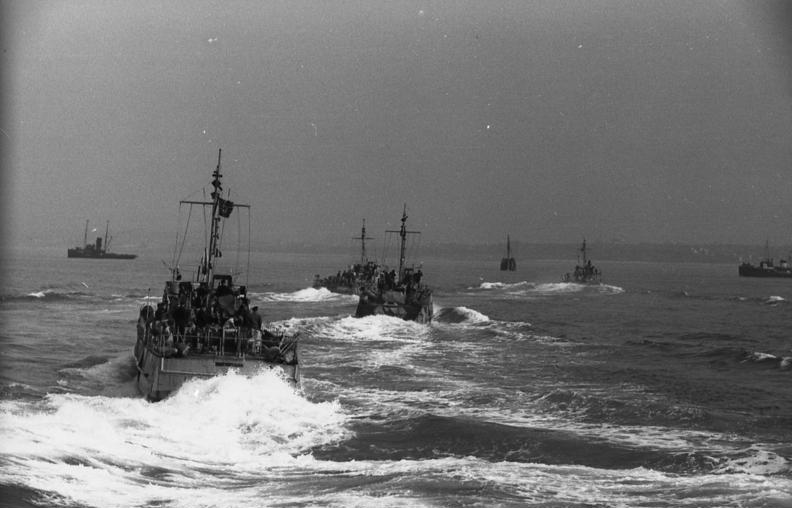
Preceded by the R25 series (1938-39, 16 units, 110 tonnes and 35.50 meters), the R41 mobilization series was heavier and more spacious. The last were put into service in 1943, they received as reinforcement two twin 20 mm mounts. 88 units were be built, making the bulk of the active flotillas in 1944.
They Displaced 125t standard, 135t Flly Loaded, and diverged in size: R41-10 measured 36.8 wl 37.8 oa whereas R102-129 were 36.8 wl 38.6 oa long, for 5.82m in beam and a draught of 1.40 normal and 1.51 deeply loaded. Some had the Voith-Schneider propulsion systems and they given either MWM (R41-48) or MAN diesels (R49-129) for 1,800 shp, 20 knots, a range of 900 nm at 15 kts based on 11.1 tons oil. They also diverged in armament. The first serie (R41-107, 109-111) had the original two single 20mm/65 C/38 guns and DCR but the second serie (R108, 112-129) received the aft single 37mm/80 SK C/30 or 37/69 FlaK M/42, three single 20mm/65 C/38, DCR, no mines. They had a crew of 30-38/ Later during the war, the early serie received alternatively the 37mm/80 SK C/30 or the 37mm/69 FlaK M/42, and all had two twin 20mm/65 C/38 where thir single mounts used to be. Sone has three single 20mm/65 C/38 or one or two twin 20mm/65 C/38 alternatively. Survivors in 1944 received the 86 R Ag M42/43 rocket launcher.

Same 3D rendition (Gaijin Ent.) of the R56.
Fate:
R41 was sunk by British MTBs. R44, R51, R52, R56, R59, R72, R79, R80, R81, R84, R89, R92, R97, R111, R119, R123, R125 and R129 by aviation. R50, R73, R77, R78, R82, R86 and R109 in German minefields. R54, R64, R74, R93, R94, R95, R110, R114, R116 and R126 by Allied mines and R66 and R70 were sunk by Soviet mines. R60, R61 and R62 sabotaged in Helsinki, R69 and R106 were claimed by Soviet aviation.

R117 as built on trials (FLICKR)
In Bundesmarine Service:
Displacement standard, 135-130 tons, 36.8 wl 38.6 oa, Aldebaran, Algol, Altair, Pegasus, Wega, UW4: 36.8 wl 37.8 oa and Arkturus, Deneb, Skorpion: 36.8 wl 38.6 oa for 5.82m wide and same draught. 2 Voith-Schneider MWM/MAN diesels, same output, speed and range. As modernized thay had two single 20mm/80 Mk 7 (HS804), a revised mechanical minesweeping gear, hydrophone, radar and a crew of 27-34.
⚙ R41 specifications |
|
| Displacement | 125 tonnes () |
| Dimensions | 37.80 x 5.80 x 1.40 m () |
| Propulsion | 2 shafts MAN diesels, 1,800 bhp |
| Speed/Range | 20 kts, diesel oil 11 tons, 900nm/15 kts |
| Armament | 1x 37mm/69 M/42 FLAK, 2×2 20mm/65 C30 AA, see notes |
| Crew | 34 |
 R 130 (mob) series (1943)
R 130 (mob) series (1943)

R178 (FLICKR)
The 20 R130 type units, built at the end of 1943, were a little more spacious and slower. They also received 3 twin 20 mm AA mounts. They were armed as standard with a single 37mm/80 SK C/30 or a 37mm/69 FlaK M/42, two twin 20mm/65 C/38 and two single ones as standard, and some received as completed a 86mm R Ag M42/43 AA RL. They all had also a DCR for ASW patrols.
Fate:
R131, R139 and R141 were sunk by Allied aircraft and R145 was torpedoed by a Soviet aircraft, lost also. Many others were damaged. There were survivors: in June 1956, Orion, Capella, Merkur, Rigel, Mars, Castor, Pollux, Sirius were recommissioned in the Bundesmarine after a modernization (notably sonar and radar) and in july Regulus, Spica, Jupiter, Saturn; in December UW5 were recommissioned. They served until the 1970s, although recoignised as too slow to deal with the latest Soviet SSNs. Instead they targeted small diesels subs like the Quebek class.
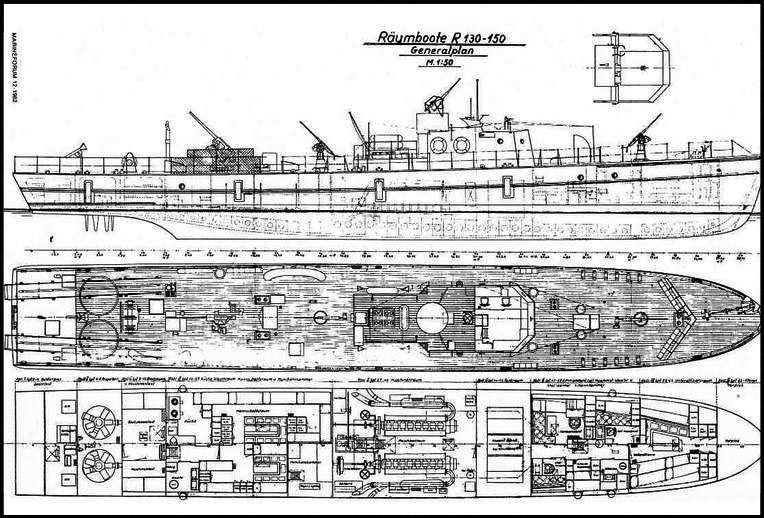
R-130-150 original plans, unfortunately i could only find the vignette.
⚙ R130 specifications |
|
| Displacement | 150 tonnes () |
| Dimensions | 41.10 x 5.80 x 1.60m () |
| Propulsion | 2 shafts MAN diesels, 1,800 bhp |
| Speed/Range | 19 kts, diesel oil 11 tons, 900nm/15 kts |
| Armament | 1x 37mm/69 M/42 FLAK, 6x 20mm/65 C30 AA, see notes |
| Crew | 38 |
 R 151 (mob) series (1943)
R 151 (mob) series (1943)
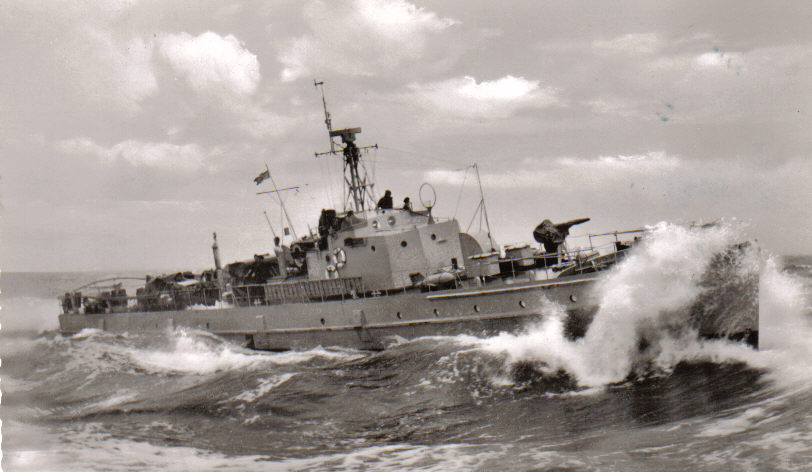
KMS Algol, by Abeking & Rasmussen.
The R151 series of 1940-43 consisted of 68 smaller but faster vessels than those of the R41 series. In 1944-45 they received six 20 mm AA cannons as reinforcement. They were faster, and equipped with mines unlike the previous series. Later during the war they were reequipped with a single aft 37mm/80 SK C/30 or 37mm/69 FlaK M/42, two twin 20mm/65 C/38 and a single DCR, plus an hydrophone.
Fate:
R151, R169, R188, R191, R193 and R204 were sunk by Soviet aircraft, R161, R186, R187, R190, R194, R200, R201, R208 and R215 Allied aircraft, R177 by a Soviet mine and R179 an Allied mine. R180, R184 and R192 were sunk by British MGBs in close surface combat.

Colorized R-Boat, src unknown, FLICKR
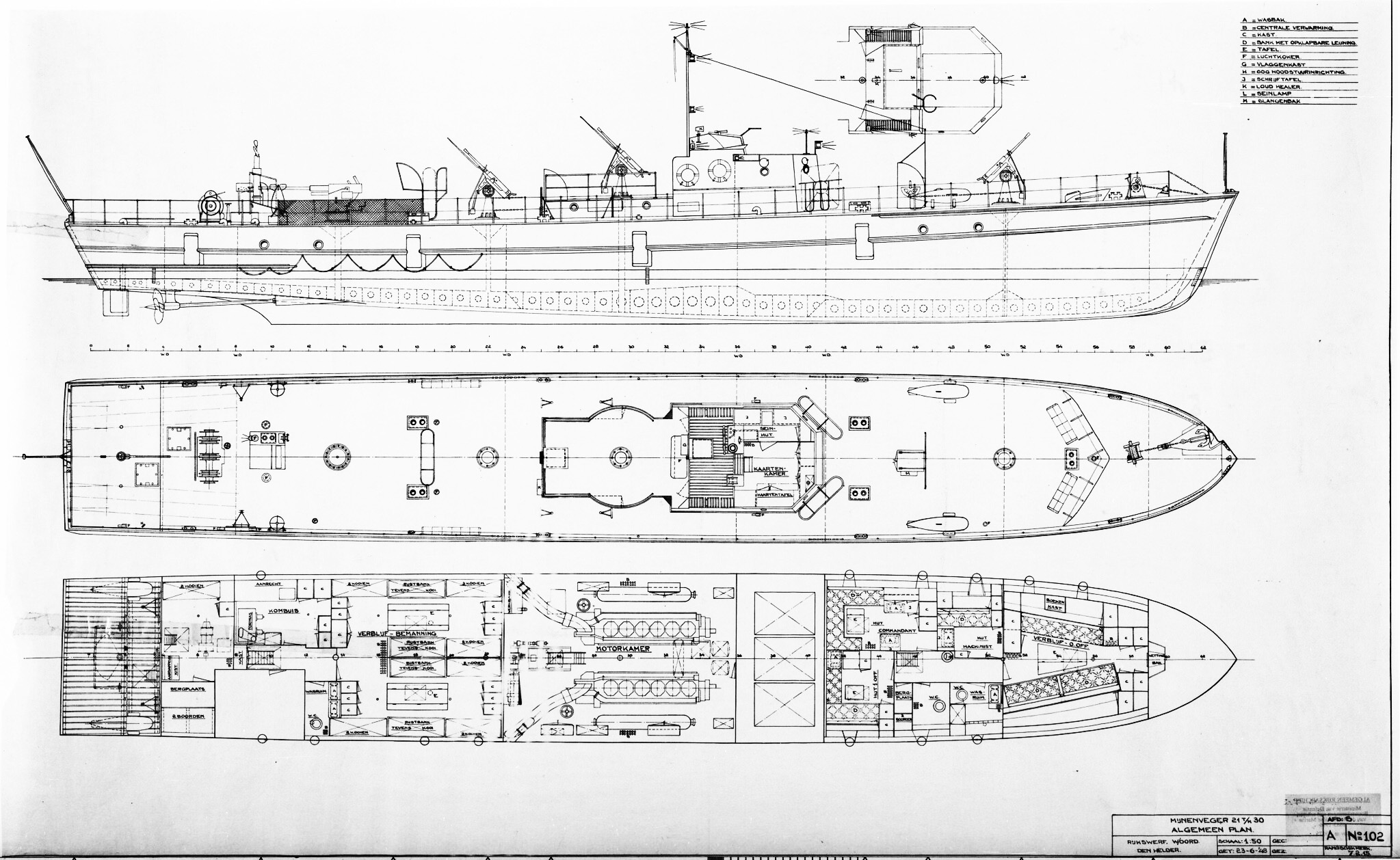
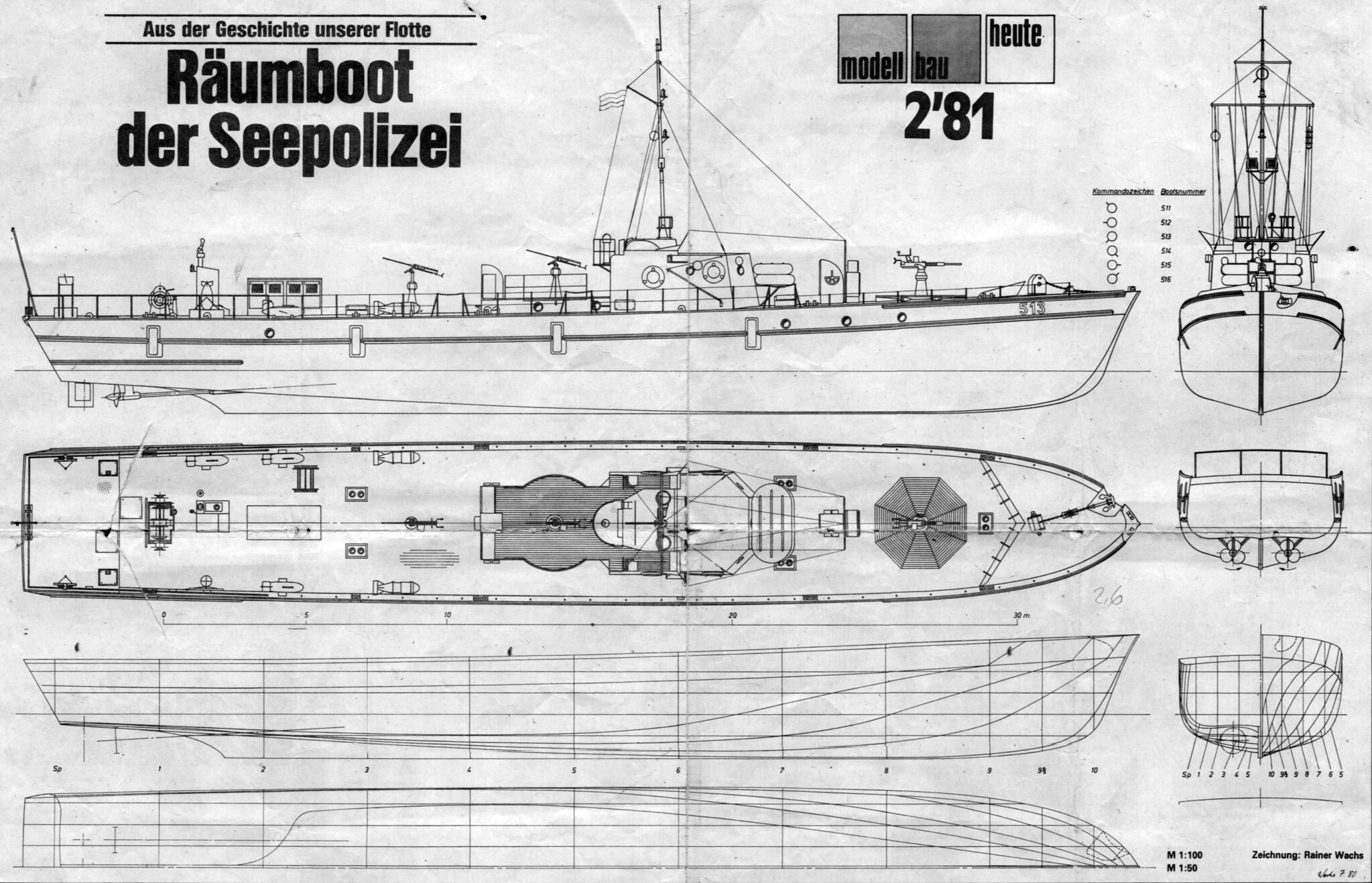
Modernized R-Boats used by the Bundesmarine, detailed plans from the Bundesarchiv
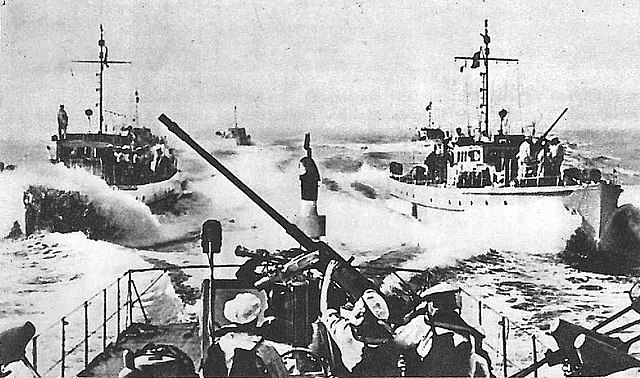
⚙ R151 specifications |
|
| Displacement | 110t standard, 126/128t FL |
| Dimensions | 35.40 x 5.60 x 1.40 m |
| Propulsion | 2 shafts MAN diesels, 1,800 bhp |
| Speed/Range | 21 kts, diesel oil 11 tons, 900nm/15 kts |
| Armament | 2x 20mm/65 C/38 AA, 10 mines, see notes |
| Crew | 38 |
 R 218 series (1944)
R 218 series (1944)
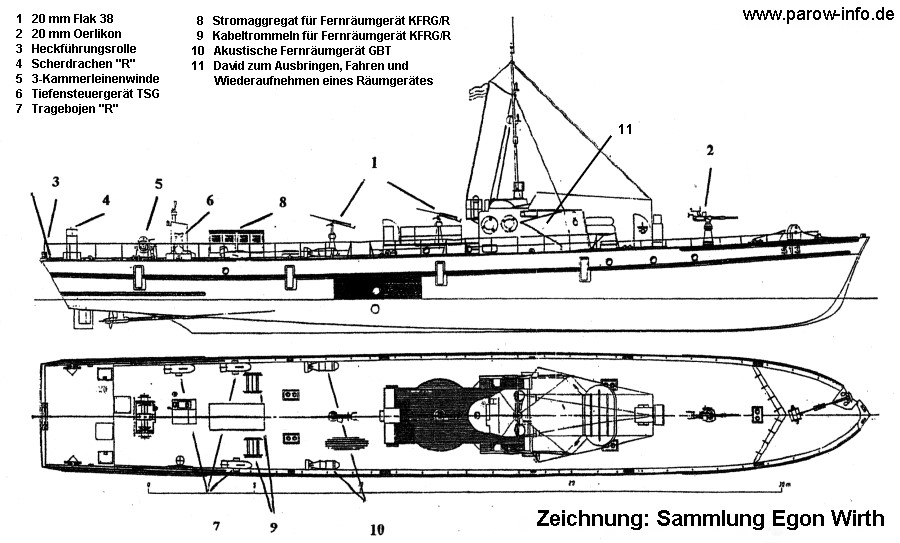
R-218 scheme – Credits parow-info.de
This last series of the war (63 units completed out of 83 planned), built at the end of 1943 at the surrender, were fairly spacious, fast, and received three twin 20 mm AA mountings shortly after their completion, making them the most heavily armed type. The 1944 S401 series was to include 23 units, never completed. R239 experimented 2 KHD diesels for 2400 shp.
As completed they had a single 37mm/80 SK C/30 or 37mm/69 FlaK M/42, three twin 20mm/65 C/38 or three single ones and 12 mines plus a DCR and hydrophone.
Fate:
R218 was sunk by British MTBs and R219 by the same, but finished off by aircraft. R221, R232, R237, R239, R250 and R261 were sunk by Allied aircraft. R222 due to a Soviet mine. R224, R227, R243, R256 and R260 by Soviet aviation, R231 disappeared without a trace. R272, R273, R274, R275 and R276 were never completed and destroyed on their slipway by Soviet aviation. 6 boats were transferred to East Germany and used by the GDR police postwar as R1-6 from May 1950, discarded 1956. R266 was attributed to the USA and sent back to the Bundesmarine in 1957 used as the border guard ship TS AT1.
⚙ R218 specifications |
|
| Displacement | 140t standard, 148t FL |
| Dimensions | 39.40 x 5.72 x 1.50/1.61 m |
| Propulsion | 2 shafts MWM diesels, 2,500 bhp |
| Speed/Range | 21 kts, diesel oil 15 tons, 1000nm/15 kts |
| Armament | 1x 37mm, 6x 20mm/65 C/38 AA, see notes |
| Crew | 40 |
 R 301 (mob) (GR) series (1943)
R 301 (mob) (GR) series (1943)
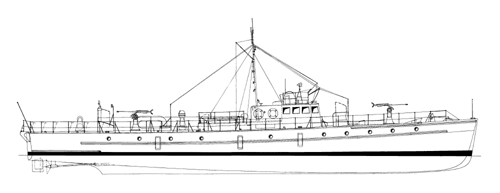
The 12 units of type R301 were larger and designed as escorts of the first, with two torpedo tubes. However they were completed far too late to be pressed in the Channel fleet as expected and ended in the Baltic. They were the heaviest of the serie, with three shafts, reaching almost 185 tonnes fully loaded. But also the fastest and with the better range and armament of all series.
R313-R320 built in Abeking & Rasmussen, Lemwerder were cancelled on 12.1943.
Basic armament comprised a single 37mm/80 SK C/30 or 37mm/69 FlaK M/42, three twin and a single 20mm/65 C/38 mm AA alternative to two twin, one single, and two 86mm R Ag M42/43 AA RL plus two 533 TTs and 16 mines as well as their mechanical minesweeping gear, DCR and hydrophone, making them pretty well-rounded, versatile ships called GR (Geleit Räumboot).
Fate:
Many were never completed, R301 and R306 were sunk by Allied aircraft and R304 hit an Allied mine. The rest were scuttled in 1945, or surrendered in 1945, being attributed to the US and Soviet Union.
⚙ R301 specifications |
|
| Displacement | 175t standard, 184t FL |
| Dimensions | 36.8/41 x 6 x 1.80/1.88 m |
| Propulsion | 3 shafts MWM diesels, 3,750 bhp |
| Speed/Range | 23.5 kts, diesel oil 15.8 tons, 716nm/20 kts |
| Armament | 1x 37mm, 7x 20mm/65 C/38 AA, 2 TTs, 16 mines, DCR, LR, see notes |
| Crew | 40 |
 R 401 series (1944)
R 401 series (1944)

The last R-Boote serie, started way too late into the war to be completed on time. They had more powerful diesels, enabling for the gretest speed of all series, 25 kts. The immense majority of the initial order was cancelled, and the remainder ships were captured on slipways by Soviet or US troops. The only one operational, R402, was sunk by Allied mine on 22.12.1944. R406 – 408 were recommissioned by border guard in 1956-1957 and modified: UW6, AT2, OT1 had a single 20mm/80 Mk 7 AA gun only. The remainder were either BU on slip or attributed to the US/Soviet Union.
⚙ R301 specifications |
|
| Displacement | 140t standard, 150t FL |
| Dimensions | 36.8/39.4 x 5.72 x 1.50/1.65 m |
| Propulsion | 2 shafts MWM diesels, 2,800 bhp |
| Speed/Range | 25 kts, diesel oil 15 tons, 1000nm/15 kts |
| Armament | 1x 37/69 FlaK M/42, 3×2 20mm/65 C/38, 2x 86mm R Ag M42/43 AARL, 12 mines, DCR, hydrophone |
| Crew | 37 |
Src/Read More
Books
Köhlers Flottenkalender 1960 und 1961
Erich Gröner: Die Schiffe der Deutschen Kriegsmarine und Luftwaffe 1939–45. Lehmanns Verlag, München 1954
Hans Mehl, Knut Schäfer: Die Seestreitkräfte der NVA. Motorbuchverlag spezial, 2004
Conway’s all the worlds fighting ships 1922-47
Links
https://www.wlb-stuttgart.de/seekrieg/minen/mrdiv2-frames.htm
http://www.parow-info.de/f/fb/R218.html
https://www.militaryfactory.com/ships/detail.php?ship_id=raumboote-rboot-minesweeper-nazi-germany
http://www.foerderverein-museums-schnellboot.de/tender/nordsee.htm
https://www.navypedia.org/ships/germany/ger_mine.htm
https://www.german-navy.de/kriegsmarine/ships/minehunter/rboat/index.html
https://de.wikipedia.org/wiki/Liste_von_Schiffen_der_Kriegsmarine
“Räumboots-Flottillen”. Lexikon der Wehrmacht
german-navy.de r-boat
Gröner, Jung, Maass U-Boats and Mine Warfare Vessels
R-Boote on military-factory
Hitler’s Armed Forces Auxiliaries: An Illustrated History.
https://alchetron.com/R-boat
https://www.shipsnostalgia.com/media/german-r-boat.437046/
https://de.wikipedia.org/wiki/Deutsche_Minenr%C3%A4umboote
https://www.german-navy.de/hochseeflotte/ships/minehunters/fm/index.html
Hervieux, Pierre German Motor Minesweepers at War 1939-1945
https://prussia.online/Data/Book/kr/kriegsmarine-coastal-forces/NV151%20-%20Kriegsmarine%20Coastal%20Forces.pdf
https://de.wikipedia.org/wiki/Deutsche_Minenr%C3%A4umboote
https://www.navypedia.org/ships/germany/ger_mine_r2.htm
R 184 Interrogation of Survivors, 1942 report, pdf
Model Kits

R3 series on scalemates.com
britmodeller.com/ r25-class
3d rendition, artstation See also (“12th man” movie)


 Latest Facebook Entry -
Latest Facebook Entry -  X(Tweeter) Naval Encyclopedia's deck archive
X(Tweeter) Naval Encyclopedia's deck archive Instagram (@navalencyc)
Instagram (@navalencyc)





 French Navy
French Navy Royal Navy
Royal Navy Russian Navy
Russian Navy Armada Espanola
Armada Espanola Austrian Navy
Austrian Navy K.u.K. Kriegsmarine
K.u.K. Kriegsmarine Dansk Marine
Dansk Marine Nautiko Hellenon
Nautiko Hellenon Koninklije Marine 1870
Koninklije Marine 1870 Marinha do Brasil
Marinha do Brasil Osmanlı Donanması
Osmanlı Donanması Marina Do Peru
Marina Do Peru Marinha do Portugal
Marinha do Portugal Regia Marina 1870
Regia Marina 1870 Nihhon Kaigun 1870
Nihhon Kaigun 1870 Preußische Marine 1870
Preußische Marine 1870 Russkiy Flot 1870
Russkiy Flot 1870 Svenska marinen
Svenska marinen Søværnet
Søværnet Union Navy
Union Navy Confederate Navy
Confederate Navy Armada de Argentina
Armada de Argentina Imperial Chinese Navy
Imperial Chinese Navy Marinha do Portugal
Marinha do Portugal Mexico
Mexico Kaiserliche Marine
Kaiserliche Marine 1898 US Navy
1898 US Navy Sovietskiy Flot
Sovietskiy Flot Royal Canadian Navy
Royal Canadian Navy Royal Australian Navy
Royal Australian Navy RNZN Fleet
RNZN Fleet Chinese Navy 1937
Chinese Navy 1937 Kriegsmarine
Kriegsmarine Chilean Navy
Chilean Navy Danish Navy
Danish Navy Finnish Navy
Finnish Navy Hellenic Navy
Hellenic Navy Polish Navy
Polish Navy Romanian Navy
Romanian Navy Turkish Navy
Turkish Navy Royal Yugoslav Navy
Royal Yugoslav Navy Royal Thai Navy
Royal Thai Navy Minor Navies
Minor Navies Albania
Albania Austria
Austria Belgium
Belgium Columbia
Columbia Costa Rica
Costa Rica Cuba
Cuba Czechoslovakia
Czechoslovakia Dominican Republic
Dominican Republic Haiti
Haiti Hungary
Hungary Honduras
Honduras Estonia
Estonia Iceland
Iceland Eire
Eire Equador
Equador Iran
Iran Iraq
Iraq Latvia
Latvia Liberia
Liberia Lithuania
Lithuania Mandchukuo
Mandchukuo Morocco
Morocco Nicaragua
Nicaragua Persia
Persia San Salvador
San Salvador Sarawak
Sarawak Uruguay
Uruguay Venezuela
Venezuela Zanzibar
Zanzibar Warsaw Pact Navies
Warsaw Pact Navies Bulgaria
Bulgaria Hungary
Hungary

 Bundesmarine
Bundesmarine Dutch Navy
Dutch Navy Hellenic Navy
Hellenic Navy Marina Militare
Marina Militare Yugoslav Navy
Yugoslav Navy Chinese Navy
Chinese Navy Indian Navy
Indian Navy Indonesian Navy
Indonesian Navy JMSDF
JMSDF North Korean Navy
North Korean Navy Pakistani Navy
Pakistani Navy Philippines Navy
Philippines Navy ROKN
ROKN Rep. of Singapore Navy
Rep. of Singapore Navy Taiwanese Navy
Taiwanese Navy IDF Navy
IDF Navy Saudi Navy
Saudi Navy Royal New Zealand Navy
Royal New Zealand Navy Egyptian Navy
Egyptian Navy South African Navy
South African Navy






























 Ukrainian Navy
Ukrainian Navy dbodesign
dbodesign